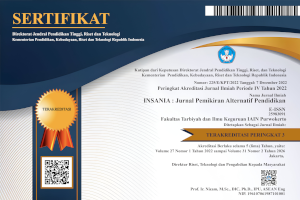Upaya Meningkatkan Kemampuan Metodologi Mahasiswa melalui Penerapan Pendekatan
DOI:
https://doi.org/10.24090/insania.v11i3.205Keywords:
Keywor learning method, Social Research Method, Student Centered LearningAbstract
Though lecturing (speech) method is simpler for lecturer because simple class organization and he can control entire class direction, but its weakness is he difficult to know whether students have understood his discussion or not. Student’s learning effectiveness generally limited, only a critical moment near final test. One effort to support the improvement of learning quality is applying Student Centered Learning (SCL) approach. SCL is an activity that therein student work individually and also as group to exploring problems, searching knowledge actively rather than passive knowledge receiver. Learning method based on the SCL more appropriate to be applied at learning process in university, especially at Social Research Method course (MPS). Following John W. Best, “the best way to learn research is to do it,†so research method not only concerning cognitive domain, but also affective and psychomotor. Among learning technique based on SCL are jigsaw technique, hypothetical situation technique, and role-playing and simulation technique. .Downloads
Downloads
How to Cite
Issue
Section
License
Authors who publish with this journal agree to the following terms:
Authors retain copyright and grant the journal right of first publication with the work simultaneously licensed under a Creative CommonsAttribution-ShareAlike License that allows others to share the work with an acknowledgment of the work's authorship and initial publication in this journal.
Authors are able to enter into separate, additional contractual arrangements for the non-exclusive distribution of the journal's published version of the work (e.g., post it to an institutional repository or publish it in a book), with an acknowledgment of its initial publication in this journal.
Authors are permitted and encouraged to post their work online (e.g., in institutional repositories or on their website) prior to and during the submission process, as it can lead to productive exchanges, as well as earlier and greater citation of published work (See The Effect of Open Access).








